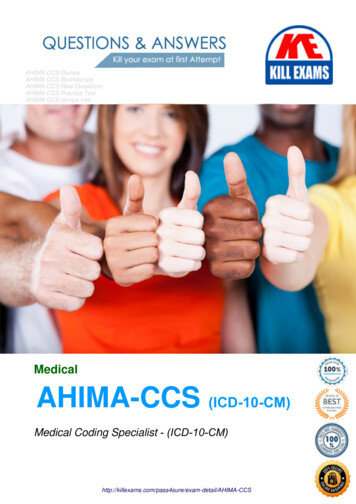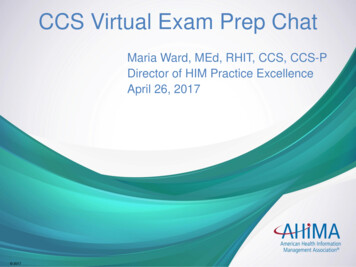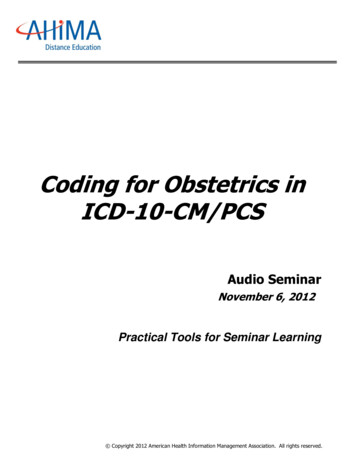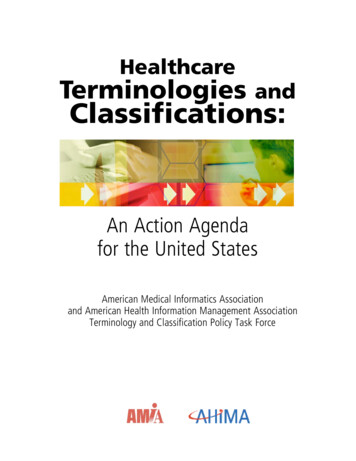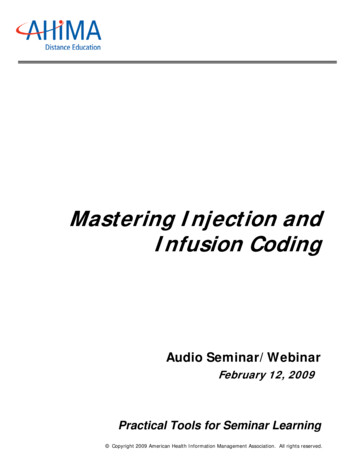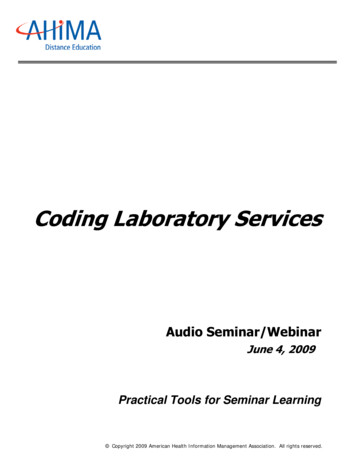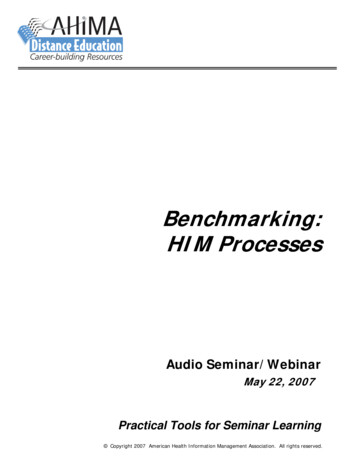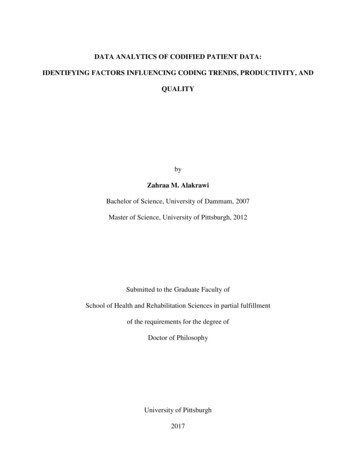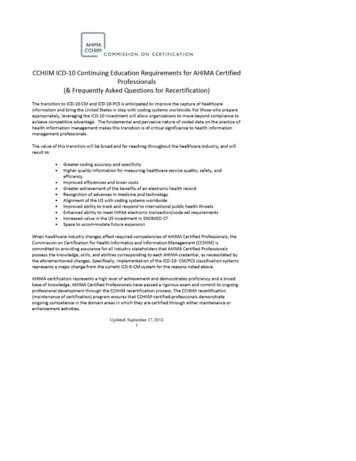
Transcription
AHIMACCHIIMCOMMISS I ON ON CERTIFICATIONCCHIIM ICD-10 Continuing Education Requirements for AHIMA CertifiedProfessionals(& Frequently Asked Questions for Recertification)The transition to ICD-10-CM and ICD-10-PCS is anticipated to improve the capture of healthcareinformation and bring the United States in step with coding systems worldwide. For those who prepareappropriately, leveraging the ICD-10 investment will allow organizations to move beyond compliance toachieve competitive advantage. The fundamental and pervasive nature of coded data on the practice ofhealth information management makes this transition is of critical significance to health informationmanagement professionals.The value of this transition will be broad and far-reaching throughout the healthcare industry, and willresult in:Greater coding accuracy and specificityHigher quality information for measuring healthcare service quality, safety, andefficiencyImproved efficiencies and lower costsGreater achievement of the benefits of an electronic health recordRecognition of advances in medicine and technologyAlignment of the US with coding systems worldwideImproved ability to track and respond to international public health threatsEnhanced ability to meet HIPAA electronic transaction/code set requirementsIncreased value in the US investment in SNOMED-CTSpace to accommodate future expansionWhen healthcare industry changes affect required competencies of AHIMA Certified Professionals, theCommission on Certification for Health Informatics and Information Management (CCHIIM) iscommitted to providing assurance for all industry stakeholders that AHIMA Certified Professionalspossess the knowledge, skills, and abilities corresponding to each AHIMA credential, as necessitated bythe aforementioned changes. Specifically, implementation of the ICD-10- CM/PCS classification systemsrepresents a major change from the current ICD-9-CM system for the reasons noted above.AHIMA certification represents a high level of achievement and demonstrates proficiency and a broadbase of knowledge. AHIMA Certified Professionals have passed a rigorous exam and commit to ongoingprofessi onal development through the CCHIIM recertification process. The CCHIIM recertification(maintenance of certification) program ensures that CCHIIM-certified professionals demonstrateongoing competence in the domain areas in which they are certified through either maintenance orenhancement activities.Updated: September 17, 2012I
In order to validate that an AHIMA Certified Professional has gained knowledge of the ICD-10-CM/PCScoding system, CCHIIM has determined that continuing education hours with ICD-10-CM/PCS contentwill be required, as applicable and relevant to the specific AHIMA credential(s) held by the individual.AHIMA Certified Professionals are employed in various roles across multiple healthcare settings, andCCHIIM recognizes a specific job function may require additional continuing educational activitiesrelated to ICD-10-CM/PCS, above and beyond the following m inimum requirements for continuingeducation credit, to be reported as continuing education credits (CEUs), per the CCHIIM recertificationpolicy.ICD-10-CM/PCS Specific CEU RequirementsAHIMA Certified Professionals are required by CCHIIM to participate in a predetermined number ofmandatory baseline educational experiences specific to ICD-10-CM/PCS. These ICD-10-CM/PCS specificCEUs will count as part of all AHIMA certificants' total CEU requirements for the purpose ofrecertifi cation. Stated differently, the following CEU requirements will be included as part of eachcertificants' total, required CEUs, by credential, per CEU Cycle.The total number of ICD-10-CM/PCS continuing education units (CEUs) required, by AHIMA credential, isas follows:CHPS-1 CEUCHDA-6 CEUsRHIT-6 CEUsRHIA- 6 CEUsCDIP -12 CEUsCCS-P- 12 CEUsCCS -18 CEUsCCA-18 CEUs*6 CEUs 1 day of training (Please see the explanation under FAQs)Certificants who hold more than one AHIMA credential w ill only report the highest number of CEUsfrom among all credentials held. For example, if a certificant has both an RH IA and CCS, the certificantwould normally report 40 {30 CEUs for RHIA and an additiona/10 CEUs for CCS} CEUs per recertificationcycle, and 18 of these CEUs will be required to cover ICD-10-CM/PCS.CCHIIM recognizes that AHIMA Certified Professionals have different levels of required competencyregarding ICD-10-CM/PCS. These levels may be as follows: Awareness of ICD-10-CM/PCS w hich may include general structure of the systems, potentialimpact to workflow processes in order to prepar e for the systems; Use of ICD-10-CM/PCS which may include analysis, trending or providing information thatinvolves coded data but not actually apply the codes in their daily jobs and requires more in depth knowledge of the systems; andUpdated: September 17, 20122
Application of ICD-10-CM/PCS which includes assigning codes on a routine bases for variouspurposes and requires a more extensive knowledge of the systems.Therefore, all certificants are encouraged to tailor their ed ucation specific to their job role. For example,if you are an RHIT and perform coding as a large percentage of your daily routine, you are encouraged tofollow the requirements set forth for those specialized coding credentials. For further role basedinformation to tailor your educational requirements http://ahima.org/icd10/role.aspx.Timellne for Accumulating ICD-10-CM/PCS CEUsAHIMA Certified Professionals can begin earning ICD-10-CM/PCS specific CEUs during the period ofJanuary 1, 2011 thru December 31, 2014.NOTE: All AHIMA Certified Professionals who completed AHIMA's Academy for ICD-10 prior to January1, 2011 will be allowed to use those CEU hours to fulfill the lCD -10-CM/PCS CE requirement.Frequently Asked Questions IFAQs)What resource(s) did CCHIIM consider when developing the baseline number of required CEUs?oICD10 Final Rule- The Department of Health and Human Services noted that estimatesof the amount of time needed for coder training varied widely between 5-80 hours.HHS stated that estimates for coder training involve five distinct areas of consideration:the training methodology; the clinical specialty; the number of inpatient and outpatientcoders; the number of hours for coder training and the cost per hour of training. HHSincreased their estimate of the number of hours that inpatient coders will need to learnboth ICD-10-CM and ICD-10-PCS from 40 hours to 50 hours, based on industry feedbackin response to the proposed rule.oBased on similar feedback from the industry expressing concern about the complexity ofICD-10-CM due to its size and structural changes, and coder unfamiliarity, theDepartment of Health and Human Services also increased from 8 to 10 hours the timethat outpatient coders will need for ICD-10-CM training.oHowever, based on feedback from a field testing project sponsored by AHIMA and theAmerican Hospital Association, it is anticipated that one to t wo days of training will benecessary for coders only needing to learn ICD-10- CM and not ICD-10-PCS. Since ICD 10-CM has the same hierarchical structure, the same basic organization, and many ofthe same conventions as ICD-9-CM, experienced coding professionals will not requirethe level of extensive training that would be necessary for an entirely new codingsystem. They will primarily need education on the changes and in the classification itselfas well as guidelines and definitions. It i s anticipated that two days of training will benecessary to learn the ICD-10-PCS system due to its' complexity and dissimilarity withthe ICD-9-CM procedure coding system.*How was 6 hours determined to be a day of training?Updated: September 17, 20123
oIn the final rule HIPAA Administrative Simplification: Modifications to Medical Data CodeSet Standards to Adopt ICD-10-CM and ICD-10-PCS days of training were discussed. Six(6) CEU's is equal to a day of training. How ever, please note that the unit of measureutilized in categorizing and reporting AHIMA CEU requirements is hours, not days.Will these requirements apply to al l AHIMA certificants?o Yes, ALL CURRENT AHIMA CERTIFICANTS will be required to comply with this mandatoryCEU policy.Why are there different requirements for different AHIMA credentials?o The credential-specific requirements primarily reflect the competencies associated withthe credential.oCCS/CCA certificants will be required to know how to apply ICD-10-CM/PCS codes todemonstrate the competence for these credentials as outlined in the content outline forthese exams. CCS-P credentialed individuals will not use or apply ICD-10-PCS codeswithin their daily duties but are required to know how to apply ICD-10-CM codes.oRHIA/RHIT certificants wi ll be required to know how to use ICD-10-CM/PCS todemonstrate the overall know ledge of those positions that they supervise or perform asoutlined in the content outline of these exams.oCHDA and CDIP certificants will be required to know the differences between the ICD-9 CM and ICD-10-CM/PCS code sets, focus on the awareness of the transition, fami liaritywith coding conventions and guidelines, how the data is comparable or not (legacydata). and an understanding of mapping and crosswalks between the classificationsystems. The CDIP exam requires additional CEUs due to the higher level of ICD-10 CM/PCS content on the exam blueprint.oCHPS certificants will need to have a generalized awareness of ICD-10 -CM/PCS codingsystems.What are the baseline ICD-10-CM/PCS CEU requirements if I hold multiple credentials?o The requirement w ill be the credential with the highest number of CEUs. For example ifa certificant holds an RHIT and CCS the baseline requirement will be a total of 18 CEUs.If I attended an AHIMA Training Academy for ICD-10 in 2009 or 2010 wil l those CEUs meet therequirement?o YES, CCHIIM will recognize CEU's awarded to participants of all AHIMA Academies forICD-10.Will the baseline ICD-10-CM/PCS CEU requirements be additional CEUs from the establishedCEU requirements for a credentialed professional?o No, CEU requirements will be included within the total number of CEUs required for agiven CEU Cycle. For example, if you hold an RHIA credential, you w ill obtain 6 CEUsUpdated: September 17, 20124
that are in relation to ICD-10-CM/PCS along with the additional 24 CEUs to completeyour recertification cycle.How will a credentialed professional report the ICD-10-CM/PCS CEUs to AHIMA?o You can report your ICD-10 specific CEUs any time before December 31, 2014. Goonline at ahima.org and log into MyAHIMA, and select "CEU Center." Next, choose" Record/Report" to submit your CEUs. Make sure to select "ICD-10" under the Domainfield.What are the specific types of recommended training areas /educational activities that willqualify for these required CEUs?o You are encouraged to tailor your CEs to the role you perform in your daily work.Examples of CEs may include: Introduction to ICD-10-basics Business Impact and Implementation Considerations Understanding General Equivalence Mappings (GEMs)ICD-10-CM Structure, Guidelines and ConventionsClinical Documentation Improvement Strategies using ICD-10 CM Biomedical Science coursework such as Anatomy and Physiology andpathophysiology refresher coursesData analysis and t rending with ICD-10-CM coded data ICD-10-CM and its effect on reimbursement methodologiesAre there stricter guidelines for the ICD-10 CM CEs than there are for my normal CErequ irements for my credential?o No, you are to be guided by the basic HIM domains as described in the RecertificationGuide which can be found at xWill there be any specific mandated activities?o No, activities that best support the current job duties should be chosen. Please refer to the chart on the next page for further information.Updated: September 17, 20125
AHIMACCHIIMCOMMISSION ON CERTIFICATIONExample- Training Areas/Educational Activities(HIM Domain: Clinical Date Management)Information Flow and ProcessesDomain: Clinical Date Menagement)mplementation Considerations & process for lCD· -ICD-10 -CM by Chapter(HIM Domain: Cllnlcel Data Menagement)Do main: Clinical Data Management)of General Equivalence MappingDocumentation Improvement StrategiesDo main: Clinical Data Management)-Biomedical Sciences (e.g. anatomy, physiology,medical terminology and pathophysiology)(HIM Domain: Clinical Foundations)-ICD-10-PCS definitions (root operations andapproaches)Domain: Clinical DataPLEASE NOTE: THE FOLLOWING TOPICS ARE GIVEN AS EXAMPLES ONLY AND ARE NOT INTENDED TO BE AN ALL-INCLUSIVE LIST.{Please refer to the Recertification Guide for specifics on HIM Domains and general Cf requirements).Awareness- of the impact of ICD-10-CM/PCS on coding and other typical health information management functions and on the healthcare industry in general. This may include anoverview of the classification system and potential impact to workflow processes in order to prepare for the system changes.Usage- ICD-10-CM/PCS which may include ana lysis, trending or providing information that involves coded data but not actually apply the codes in their daily jobs and requires more in depth knowledge of the systemsApplication- of ICD-10-CM/PCS which includes assigning codes on a routine bases for various purposes and requires a more extensive knowledge of the systems."Certificants are encouraged to tailor their education specific to their job role. For example, if you are an RHIA but do coding in your daily routine for a large percentage of your jobtasks, then you are encouraged to follow the requirements set forth for those specialized coding credentials. For further role based information click here .CCHIIM will recognize CEU's awarded to participants ofall AHIMA Academies for /CD-10 CM/PCS.
The total number of ICD-10-CM/PCS continuing education units (CEUs) required, by AHIMA credential, is as follows: CHPS-1 CEU CHDA-6 CEUs RHIT-6 CEUs RHIA-6 CEUs CDIP -12 CEUs CCS-P-12 CEUs CCS -18 CEUs CCA-18 CEUs *6 CEUs 1 day oftraining (Please see the explanation under FAQs) Certificants who hold more than one AHIMA credential w ill
